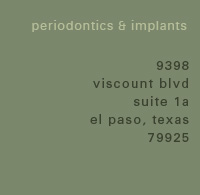- general information
- patient information
- Periodontal Overview
- ––––––––––––––––––––––––––––––––––
- Periodontal Disease and Heart Disease
- Diabetes and Periodontal Diseases
- Periodontal Disease Risk Factors
- Periodontal Complications
- Oral Cancer
- • Biopsy
- Maintaining Periodontal Health throughout a Woman's Lifetime
- Other Diseases and Their Relationship to Periodontal Disease
- Heart Disease: Precautions to be Taken Before Dental Treatment
- Poor Nutrition and Periodontal Disease
- ––––––––––––––––––––––––––––––––––
- What is "Good Oral Hygiene"?
- How to Brush
- How to Floss
- How to Care for Sensitive Teeth
- Hygiene Products
- • Toothbrush Care
- ––––––––––––––––––––––––––––––––––
- New Patient FAQs
- First Visits FAQs
- non-surgical periodontal care
- periodontal therapies
- Traditional Pocket Reduction Therapy
- • Bone Grafting
- ––––––––––––––––––––––––––––––––––
- PerioLase™ LANAP Therapy
- ––––––––––––––––––––––––––––––––––
- Cosmetic Surgery to Improve the Appearance of Your Smile
- • Crown Lengthening to Improve the Esthetics of Your Smile
- • Soft Tissue Grafting to Address Gingival Recession (Root Coverage Grafting)
- Platelet Rich Plasma (PRP)
- Crown Lengthening to Repair a Damaged Tooth
- Exposure / Bracketing of Impacted Tooth
- • Procedure Description for Exposure/Bracketing of Impacted Tooth
- ––––––––––––––––––––––––––––––––––
- Pocket Reduction Surgery FAQs
- Other Therapies FAQs
- dental implants
- Introduction to Dental Implants
- • Single Missing Tooth
- • Two or More Missing Teeth
- • Current Denture User
- • Benefits of Dental Implants
- ––––––––––––––––––––––––––––––––––
- CT Scanner & Comprehensive Implant Planning
- Conscious I.V. Sedation: Is It Right for You?
- ––––––––––––––––––––––––––––––––––
- Socket Preservation Techniques
- Ridge Augmentation and Bone Grafting
- Sinus Graft
- Platelet Rich Plasma
- Routine Implant Maintenance
- our doctors & staff
- office information






Home
Patient Information
- Periodontal Overview
- Periodontal Disease and Heart Disease
- Diabetes and Periodontal Diseases
- Periodontal Disease Risk Factors
- Periodontal Complications
- Oral Cancer
- • Biopsy
- Maintaining Periodontal Health throughout a Woman's Lifetime
- Other Diseases and Their Relationship to Periodontal Disease
- Heart Disease: Precautions to be Taken Before Dental Treatment
- Poor Nutrition and Periodontal Disease
- What is "Good Oral Hygiene"?
- How to Brush
- How to Floss
- How to Care for Sensitive Teeth
- Hygiene Products
- • Toothbrush Care
- New Patient FAQs
- First Visits FAQs
New Patient Frequently Asked Questions and Answers
1. WHAT IS A PERIODONTIST?
2. WHAT IS PERIODONTAL DISEASE?
3. WHAT CAUSES PERIODONTAL DISEASE?
4. WHAT ARE OTHER CONTRIBUTING CAUSES OF PERIODONTAL DISEASES?
5. WHAT ARE THE SIGNS AND SYMPTOMS OF PERIODONTAL DISEASE?
6. ARE ALL PERIODONTAL DISEASES THE SAME?
7. WHO IS AT “RISK” FOR PERIODONTAL DISEASE?
8. HOW ARE PERIODONTAL DISEASES TREATED?
9. HOW CAN PERIODONTAL DISEASES BE PREVENTED?
10. WHEN SHOULD I SEE A PERIODONTIST?
11. WHAT PRECAUTIONS SHOULD BE TAKEN BEFORE DENTAL TREATMENT? (no text for this topic provided_
1. WHAT IS A PERIODONTIST?
A Periodontist is a dentist who specializes in the prevention, diagnosis, and treatment of the various types of periodontal diseases, and the surgical placement and maintenance of dental implants. In order to become a Periodontist, one must first graduate from an accredited college where most applicants concentrate in a degree in one of the science fields. The next step is to attend Dental School for a period of four years where they graduate with a “Doctor of Dental Surgery degree; Doctors who then apply to enter the specialty of Periodontics and Implant Surgery are required to complete a three year residency in Periodontics and Implant Surgery at a major university or medical center. In addition, Drs. Caldwell and Dimmitt have completed extensive Post Graduate Training Programs in comprehensive treatment planning, bone reconstruction, and dental implant placement and restoration—all with the goal of providing state-of-the-art surgical care. Our doctors are also trained in a variety of cosmetic periodontal procedures to help you achieve the smile you desire. Not only that, our doctors teach these advanced implant surgical procedures to other surgeons, in their role as Surgical Faculty members at both the prestigious Misch International Implant Institute in Detroit Michigan, and Temple University’s School of Dentistry in Philadelphia.
Often General Dentists refer their patients to us when periodontal disease is present, or when surgery to treat various diseases is required, but a direct referral isn’t always mandatory. If you or your loved one are aware of problems related to gum disease like pus and tooth mobility, or have a desire to learn more about dental implants for the replacement of missing teeth, please call our staff for an examination and consultation. The greatest compliment our patients can give is their referral of friends and family.
2. WHAT IS PERIODONTAL DISEASE?
The word “periodontal” literally means around the tooth. Periodontal diseases are chronic bacterial gum infections that destroy the attachment fibers and supporting bone that hold your teeth in your mouth. The main cause of these diseases is bacterial plaque, a sticky, colorless film that constantly forms on your teeth, as well as your body’s response to this plaque. Daily home oral care, including proper brushing and flossing, is a must to prevent plaque buildup.
If plaque is not removed, it can turn into a hard substance called calculus (tartar) that is so hard it can only be removed during a professional cleaning. If calculus develops below the gums on the tooth root, it makes plaque removal difficult, leaving you at increased risk for periodontal diseases.
In the mildest form of the disease called “gingivitis”, the gums redden, swell, and bleed easily. There is usually little or no discomfort. Gingivitis is often caused by inadequate oral hygiene, and is usually reversible with periodontal treatment and good oral home care.
The production of toxins (or poisons) by the bacteria found in plaque irritate the gums, contributing to infection. These toxins can be described as a “trigger” in a process that initiates an inflammatory process that ultimately destroys the supporting tissues around the teeth, including the bone. Some patients have an overreaction to the bacteria and their body’s immune response, causing further damage. Bacteria and your immune response to the bacteria can cause the gums to separate from the teeth, forming pockets that fill with even more plaque and more infection. As the disease progresses, these pockets deepen, more gum tissue and bone are destroyed, and the teeth eventually become loose. If periodontal diseases are not treated, the teeth may need to be removed and often the destruction has progressed to a point that makes replacement of these teeth difficult. In addition, developing research links periodontal diseases to general health conditions such as heart disease, diabetes, respiratory disease, and preterm and low birth weight babies.
VIDEO – Advanced Periodontitis Video
3. WHAT ARE OTHER CONTRIBUTING CAUSES OF PERIODONTAL DISEASES?
Remember, plaque is the culprit, which means that without proper at-home oral hygiene and regular dental visits, your risk clearly increases. However, even perfect oral hygiene isn’t enough to ward off periodontal disease in everyone. Other risk factors for the accelerated development and exacerbation of periodontal diseases include tobacco use, certain health conditions and life span changes, medications, stress, genetics, and poor nutrition.
Multiple factors can adversely affect the health of your gums and ultimately contribute to the development of periodontal diseases. Tobacco use (all forms) not only increases the risk of developing periodontal diseases significantly, but it can also negatively affect treatment efforts to eliminate it. Other risks are:
- Hormonal changes during puberty, pregnancy, or menopause can cause the gums to become red, tender, and bleed easily.
- Genetics and family history of periodontal diseases indicate a greater likelihood for the development of these diseases, and in some situations this can lead to an exaggerated destructive response to the disease processes.
- Stress can make a patient more susceptible to periodontal disease or it can make it more difficult for the body to fight off ill effects of periodontal infections.
- Poor nutrition can also make it harder for the body to fight off infection.
- Some prescription drugs, such as oral contraceptives, anti-depressants, anticonvulsants, and certain heart medications, can adversely affect oral health.
- Destructive habits, such as improper oral hygiene technique, oral piercing, drug or alcohol abuses can affect periodontal health.
- Some systemic diseases that interfere with the body’s immune system consequently worsen the condition of the gums and supporting bone.
4. WHAT ARE THE SIGNS AND SYMPTOMS OF PERIODONTAL DISEASE?
Periodontal diseases are often silent; meaning that symptoms may not materialize until significant bone loss has occurred. Some people may have periodontitis and not experience any symptoms; unaware that they have disease. Common signs and symptoms of periodontal diseases include:
- Red, swollen, or tender gums
- Bleeding while brushing or flossing
- Gums pulling away from the teeth making teeth appear longer
- Loose or separating teeth
- Pus between the gum and tooth
- Persistent bad breath
- A change in the way your teeth fit together when you bite
- A change in the fit of partial dentures
If you notice any of these symptoms, you should have a complete periodontal examination by one of our Periodontists.
During your periodontal examination, our Doctor will gently place a small measuring instrument called a periodontal probe in the pocket between the teeth and gums to measure pocket depths and help make a diagnosis. Probing depths measuring 1-3mm are usually considered healthy. Four to 5mm may indicate mild periodontitis, 5-6mm suggest moderate periodontitis, and 7mm and greater may indicate severe periodontitis. In addition to probing depth measurements, detailed X-rays are usually taken to evaluate the health of the bone supporting the teeth.
5. ARE ALL PERIODONTAL DISEASES THE SAME? VIDEO – Advanced Periodontitis Video.
There are many types of periodontal disease. The following is an overview of the most common forms:
- Gingivitis – As the mildest form of the periodontal diseases, gingivitis causes the gums to become red, swollen, and bleed easily. There is usually minimal discomfort at this stage.
- Chronic Periodontitis – Chronic periodontitis is a condition resulting in inflammation within the soft tissues surrounding the teeth, causing progressive soft tissue detachment and supporting bone loss. It is diagnosed with evidence of bone loss on a dental X-ray, the formation of gum pockets, and/or receding gums. It is most common in adults, but can occur at any age.
- Aggressive Periodontitis
- Localized Aggressive Periodontitis – Most often occurs near puberty and usually involves attachment loss around first molars and/or front teeth but may involve one or two additional teeth.
- Generalized Aggressive Periodontitis – Usually, but not always affects people under 30 years of age. It involves attachment loss on at least three permanent teeth in addition to first molars and incisors and the destructive process is exaggerated and these cases can show a decreased response to conventional periodontal care.
- Periodontitis as a Manifestation of Systemic Disease – As the name indicates, this form is associated with one of several systemic diseases that are related to periodontitis, such as diabetes.
- Necrotizing Periodontal Diseases – These types of periodontal diseases cause ulcers in the gums between the teeth and are most commonly observed in individuals with certain conditions including, but not limited to, HIV infection, malnutrition, and immune-suppression. Stress, smoking, and poor oral hygiene, sometimes can contribute to this problem.
7. WHO IS AT “RISK” FOR PERIODONTAL DISEASE?
You are likely to have periodontal disease at some point during your lifetime. It can develop it at any age. In fact, periodontal disease is one of the most prevalent diseases known to man.
More than one in three people over age 30 have a form of periodontal disease that has advanced beyond gingivitis. However, because periodontal disease develops silently and painlessly, the majority of people do not even realize they have it.
It is important to know the status of your periodontal health because periodontal disease and dental decay are the primary causes of adult tooth loss. Even more importantly, recent research has established a relationship between periodontal infection and more serious health problems, such as cardiovascular disease, diabetes, respiratory disease, and preterm or low birth weight babies. So, if you don’t know, ask your dentist, or call our office for a consultation.
As you can see, good periodontal health is a key component of a healthy body.
8. HOW ARE PERIODONTAL DISEASES TREATED?
Once your periodontal health has been evaluated, your Periodontist will work with you to determine the best treatment options to control your disease and bring you back to health. Treatment options depend on the stage of disease progression. If diagnosed and treated early, simple non-surgical periodontal therapy may be sufficient. Advanced cases with significant periodontal pocket depths and bone loss may require surgical therapy.
Once periodontitis has been controlled, patients will require ongoing periodontal maintenance procedures to sustain health. This ongoing phase of treatment will allow our doctors to assess your periodontal health and make sure that your infection is kept under control. During these cleaning and re-evaluation appointments, your mouth will be examined, new calculus and plaque will be removed and, if necessary, your teeth will be polished and your bite will be checked. Periodontal diseases are chronic disease, just like diabetes. Without careful, ongoing treatment, periodontal diseases can and often do recur.
9. HOW CAN PERIODONTAL DISEASES BE PREVENTED?
Good oral hygiene and professional care are the keys to keeping your teeth for a lifetime. The best way to prevent periodontal diseases and tooth decay is the daily removal of the bacterial plaque by thorough brushing and flossing, as well as regular dental visits that include a periodontal exam and professional cleaning achieving periodontal health. Preventing and/or controlling periodontal disease is a worthwhile commitment that will keep you smiling for life.
10. WHEN SHOULD I SEE A PERIODONTIST?
If you value your oral as well as overall health, anytime is a good time to see a Periodontist for a periodontal evaluation. Sometimes the only way to detect periodontal disease is through a periodontal evaluation. A periodontal evaluation may be especially important if you:
A. Notice any symptoms of periodontal disease, including:
- Gums that bleed easily, such as during brushing or flossing
- Red, swollen or tender gums
- Gums that have pulled away from the teeth
- Persistent bad breath
- Pus between the teeth and gums
- Loose or separating teeth
- A change in the way your teeth fit together when you bite.
B. Are thinking of becoming pregnant. Pregnant women who have periodontal disease may be seven times more likely to have a baby born too early and too small. In addition, about half of pregnant women experience “pregnancy gingivitis.” However, women with good oral hygiene and no prior history of gingivitis before pregnancy are very unlikely to experience this condition.
C. Have a family member with periodontal disease. Research suggests that the bacteria that cause periodontal disease can be passed through saliva. This means the common contact of saliva in families puts children and couples at risk for contracting the periodontal disease of another family.
D. Have heart disease, diabetes, respiratory disease or osteoporosis. Ongoing research is showing that periodontal disease is a contributing risk factor to these conditions. The bacteria associated with periodontal disease can travel into the blood stream and pose a threat to other parts of the body. Healthy gums may lead to a healthier body.
E. Feel that your teeth are too short or that your smile is too “gummy.” Or, if you are missing one or more of your teeth and are interested in a long-lasting replacement option.
F. Are not satisfied with your current tooth replacement option, such as a bridge or dentures, and may be interested in dental implants.
G. Have a sore or irritation in your mouth that does not get better within two weeks.
11. WHAT PRECAUTIONS SHOULD BE TAKEN BEFORE DENTAL TREATMENT?
This section of our website is in development. We apologize for the inconvenience, please check back later.
9398 Viscount Blvd, Suite 1-A | El Paso, TX 79925 | Tel 915-598-6702 | Fax 915-593-7478
Home | General Information | Patient Information | Non-Surgical Periodontal Care | Periodontal Therapies | Dental Implants | Our Doctors & Staff
Contact Us | Referring Doctors | Disclaimer | Sitemap | Periodontic Website Designby PBHS 2012©